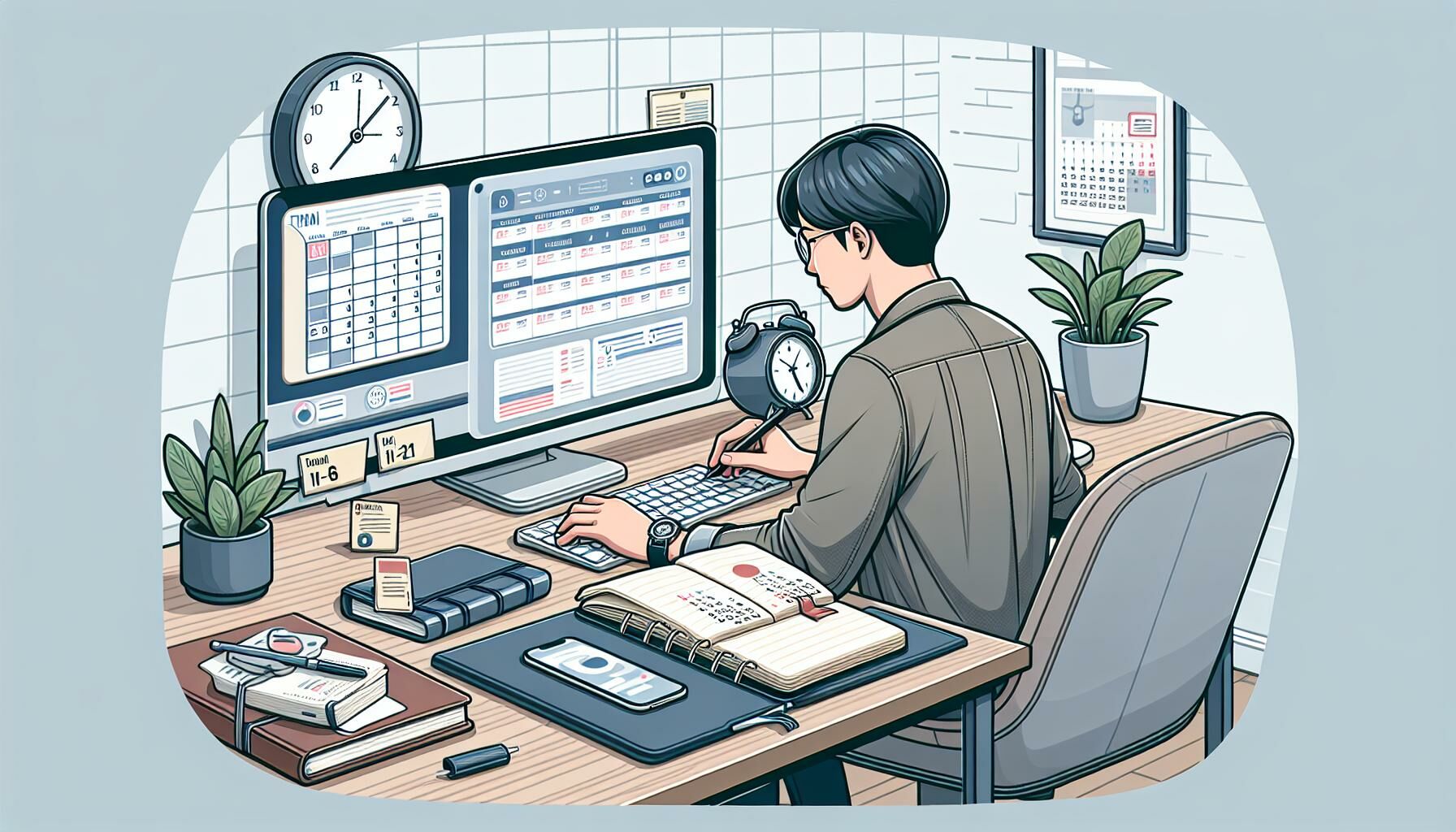Essential time management tips for professional growth

In today’s fast-paced world, managing time efficiently has become more crucial than ever. Whether it’s juggling work deadlines, personal commitments, or simply finding time to relax, mastering the art of time management can lead to a more productive and balanced life. This article delves into the realm of time management, offering a selection of powerful practices that promise to streamline both personal and teamwork processes. By optimising the use of working hours, these tips aim to enhance the quality of output, ensuring that every minute counts.
Time management tips

1. Figure out how you’re currently spending your time
Enhancing time management skills starts with a thorough evaluation of how one currently allocates their time. This process, akin to performing a personal audit, demands systematic tracking of activities to gain detailed insights into daily routines. By recording every activity over the course of a week using digital tools such as apps and spreadsheets, individuals can achieve a comprehensive understanding of their habits. Such analysis sheds light on areas of inefficiency and reveals potential for optimization. With this information at hand, it becomes possible to align tasks more closely with one’s core goals and values. Implementing this structured approach facilitates the elimination of unnecessary tasks, freeing up space for more impactful endeavours that significantly enhance life quality. In essence, acquiring knowledge about our time usage empowers us to refine our time management strategies, ensuring they are in harmony with our top priorities.
2. Create a daily schedule—and stick with it
Creating a daily schedule is crucial for effective time management, helping individuals to clearly outline their tasks and balance work and personal life. Prioritising tasks ensures that important activities are focused on first, with digital tools aiding in visual planning. Consistency in following the schedule necessitates discipline but should include breaks to boost long-term productivity. The capability to adapt the schedule for unforeseen events reflects proficient time management skills. Reflecting on the day’s achievements and areas for improvement is vital for continuous development. Overall, a well-maintained daily schedule fosters enhanced productivity and a balanced lifestyle by requiring prioritisation, discipline, flexibility, and reflection.
3. Prioritise wisely
Effective time management relies on prioritising tasks by discerning between what is urgent and important, a skill enhanced by using the Eisenhower Box, which categorises tasks into four quadrants. This method helps in focusing on crucial deadlines first to avoid last-minute rushes. Prioritising also involves assessing the value of each activity towards achieving goals, extending beyond professional tasks to personal ambitions as well. A practical approach includes listing tasks in order of priority daily or utilising digital tools for better organization.
4. Group similar tasks together
Grouping similar tasks, known as batching or batch processing, is a highly effective time management strategy that enhances productivity and organises workflow. By focusing on related tasks in dedicated time blocks, this method reduces the inefficiency of multitasking. It allows for deeper focus by categorising tasks based on their nature or objective and setting specific times for activities like answering emails or meetings. This approach aids in achieving work-life balance and better time allocation by making scheduling more accurate, adhering to Parkinson’s Law that work should fit into the allotted time. Incorporating technology, such as AI tools, can further improve this strategy by handling repetitive tasks and reducing distractions. Grouping tasks is a cornerstone of efficient time management, transforming an overwhelming schedule into a manageable and productive routine.
5. Avoid the urge to multitask
To boost productivity, it’s best to avoid multitasking. Multitasking might seem like a way to increase efficiency, but it usually hinders focus and reduces the quality of work. Focusing on one task at a time is recommended. Adopting single-tasking can lead to faster completion of tasks and greatly enhance the quality of results.
- Focus on one task at a time: Focusing solely on one task at a time not only improves the quality of your work but also helps you complete it more quickly. By dedicating specific blocks of time to different tasks, you can greatly enhance your engagement and boost both concentration and productivity. This strategy is in perfect harmony with the batching method mentioned earlier, which recommends tackling similar tasks together during set periods.
- Recognise the costs of multitasking: Understanding the drawbacks of multitasking—such as increased stress levels and the potential for errors—motivates individuals to adopt more linear work methods. Studies highlight how multitasking can significantly impair cognitive performance, underscoring the efficiency of focusing on one activity at a time.
- Implement tools and techniques: Leveraging technology and adopting time management strategies, such as the Pomodoro Technique or timeboxing, can aid in resisting the multitasking impulse. Setting timers for work sessions on a single task before taking a break cultivates discipline and improves time management. These techniques encourage productivity through structured intervals, ensuring tasks receive the focused attention they require.
- Evaluate and adjust: Periodic self-evaluation helps in identifying multitasking habits and devising strategies to overcome them. Setting realistic goals for task completion and reflecting on daily work patterns can reveal insights into how multitasking impacts personal efficiency. This ongoing process allows for adjustments in work habits, fostering a more productive and focused approach to task management.
By understanding the inefficacy of multitasking and implementing focused time management tips, individuals can enhance their productivity significantly. Embracing these strategies reduces stress, minimises errors, and ensures the completion of tasks to the highest standard, marking a significant stride towards achieving professional and personal success.
6. Assign time limits to tasks
Implementing time limits on tasks is a highly effective method for boosting productivity and preventing projects from becoming overly time-consuming. This strategy focuses on ensuring that work does not stretch to fill the available time, thereby enhancing efficiency and output quality. By setting strict deadlines, one can effectively tackle procrastination and perfectionism, much like breaking down a large project into smaller, manageable parts with individual deadlines. This approach improves concentration and speed, ensuring efforts are focused solely on priorities.
However, the successful application of this technique requires discipline, an accurate evaluation of one’s abilities, and possibly the use of digital time management tools. It significantly lowers stress levels by bringing structure to the workday and elevating the quality of results through a commitment to focusing on one task at a time. Thus, imposing time constraints on tasks shows that setting limits is sometimes exactly what’s needed to enhance efficiency and produce superior work.
7. Build in buffers
Incorporating buffers into one’s schedule is a crucial time management strategy that is often overlooked. These buffers are intentional breaks—small pockets of time set aside between tasks or meetings. They serve a dual purpose: they not only provide a mental and physical break but also act as a safeguard against unexpected delays or overruns, ensuring that the day’s agenda doesn’t collapse under the weight of a single delayed task.
Here’s how to effectively build in buffers:
- Assess task duration: Start by evaluating how long tasks typically take and then add a 10 to 15-minute buffer. This step counteracts the common pitfall of underestimating task duration, a frequent issue that hinders effective time management.
- Scheduled breaks: Just as critical as the tasks themselves, scheduled breaks replenish energy levels and boost focus. A 5- to 10-minute break every hour can significantly increase productivity and lower stress levels.
- Plan for the unexpected: Allocate specific times in the day, perhaps before lunch or at the end of the day, to address unexpected tasks or to catch up on work that took longer than anticipated. This flexibility reduces the pressure to rush tasks and enhances overall work quality.
- Use technology: leverage digital calendars and scheduling tools to visually incorporate buffers into the day. Seeing these buffers can reinforce their importance and help individuals resist the temptation to fill every minute with tasks.
By building buffers into their schedules, individuals can improve their time management skills, leading to a more balanced and productive routine. This strategy acknowledges the reality of workday dynamics, accommodating for the inevitable delays and distractions in a proactive manner. It ensures that individuals remain on track, even when the unexpected occurs, embodying a realistic approach to time management that champions efficiency and well-being.
8. Learn to say no
Mastering the art of saying no is crucial for effective time management, allowing individuals to prioritise tasks that align with their goals and avoid overcommitment. This skill enables better focus on priorities, enhances productivity, and improves well-being by preventing workload overload. Implementing this involves discernment in recognising non-aligned tasks, clear communication when declining requests while maintaining positive relationships, and setting personal boundaries to manage one’s time efficiently. Although challenging at first, learning to say no is essential to working smarter and navigating the high demands of the modern workplace, ultimately reclaiming control over one’s schedule.
9. Get organised
- Clean your workspace: A tidy desk isn’t just visually appealing; it’s a cornerstone of efficiency. Research cited by National Geographic emphasises the cognitive benefits of minimising clutter. Less clutter equals lower stress levels and sharper decision-making. Tossing unnecessary papers and arranging essential tools within reach simplifies the work environment, fostering a productive setting for executing time management strategies.
- Digital file coordination: In the realm of digital organisation, file management stands paramount. A coherent system for naming and storing files on computers and shared drives ensures that valuable time isn’t wasted searching for documents. This practice aligns with effective time management by streamlining access to necessary resources, thereby speeding up work processes and collaboration efforts.
- Utilise a calendar: Adopting a calendar organised by life’s various segments—personal, professional, and commitments—enhances one’s ability to manage time effectively. Colour-coding tasks based on urgency or category further refine this system, making it quicker to identify priorities at a glance. Employing such a calendar system is a proactive step in applying time management tips to ensure every minute of the day is used productively.
- Embrace the positive and negative sides of POSEC: The POSEC method, while beneficial for balancing work and personal life, may not be the most practical for daily task organization. However, understanding its advantages and disadvantages enriches one’s arsenal of time management strategies, enabling individuals to choose the most appropriate tools for their unique situations.
- Bullet journal method: The Bullet Journal, commonly referred to as BuJo, is a vital organisational tool. It includes an index page, a future log, a monthly log, and a daily log for documenting present activities and future commitments. This method acts like having a personal assistant in your notebook. However, its benefits extend beyond simple task management or date keeping; it excels in helping users set meaningful goals and track their progress towards achieving them. The BuJo method enhances planning skills and applies effective goal-setting strategies to overcome typical time management challenges like missed deadlines or cluttered schedules. By doing so, it offers a comprehensive solution for improving personal organisation and productivity.
10. Eliminate distractions
Achieving mastery in time management requires both the adoption of new strategies and the elimination of productivity-reducing factors. Distractions are everywhere, from mobile device notifications to cluttered workspaces, all significantly impacting concentration levels. It is essential to identify and address these efficiency-impairing elements to improve performance and maintain a healthy balance between professional responsibilities and personal downtime.
Strategies for enhancing focus include organising your workspace, leveraging apps designed to reduce distractions, or implementing a strict schedule that separates work periods from breaks. The goal is to foster an environment that supports concentrated effort, free from interruptions. By striking this balance, each day becomes an opportunity to progress towards your goals while ensuring ample time for relaxation and enjoyment.
There are lots of advantages of time management, please check out our article on ‘The benefits of time management on professional growth.‘
Latest Thailand News
Follow The Thaiger on Google News:


























